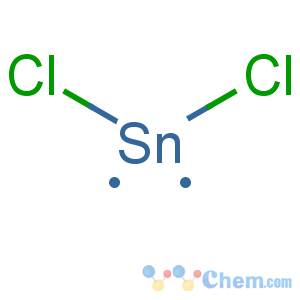Title: Stannous Chloride
CAS Registry Number: 7772-99-8
Synonyms: Tin dichloride; tin protochloride
Trademarks: Stannochlor
Molecular Formula: Cl2Sn
Molecular Weight: 189.62
Percent Composition: Cl 37.39%, Sn 62.60%
Line Formula: SnCl2
Literature References: Prepn: Stephen,
J. Chem. Soc. 1930, 2786; Williams,
Org. Synth. coll. vol. III, 627 (1955). Metabolism and toxicity studies: M. Marciniak,
Acta Physiol. Pol. 32, 193 (1981); P. P. Singh, A. Y. Junnarkar,
Indian J. Pharmacol. 23, 153 (1991). Review of toxicology and human exposure:
Toxicological Profile for Tin (PB2006-100006, 2005) 426 pp.
Properties: Orthorhombic cryst mass or flakes; fatty appearance. bp 247°; d 3.95. Sol in water, ethanol, acetone, ether, methyl acetate, methyl ethyl ketone, isobutyl alcohol. Practically insol in mineral spirits, petr naphtha, xylene. LD50 in mice, rats (mg/kg): 1710.0, 2000.0 orally; 271.0, 316.0 i.p.; 34.8, 43.0 i.v. (Singh, Junnarkar).
Boiling point: bp 247°
Density: d 3.95
Toxicity data: LD50 in mice, rats (mg/kg): 1710.0, 2000.0 orally; 271.0, 316.0 i.p.; 34.8, 43.0 i.v. (Singh, Junnarkar)
Derivative Type: Dihydrate
CAS Registry Number: 10025-69-1
Molecular Formula: Cl2Sn.2H2O
Molecular Weight: 225.65
Percent Composition: Cl 31.42%, Sn 52.61%, H 1.79%, O 14.18%
Properties: Crystals; absorbs oxygen from air and forms insol oxychloride. d 2.71. mp 37-38° when rapidly heated; dec on strong heating. Sol in less than its own wt of water; with much water it forms an insol basic salt; very sol in dil or in concd hydrochloric acid; also sol in alcohol, ethyl acetate, glacial acetic acid, sodium hydroxide soln.
Keep tightly closed, in a cool place.
Melting point: mp 37-38° when rapidly heated
Density: d 2.71
Use: Powerful reducing agent, particularly in manuf of dyes and 99mTc radiopharmaceuticals; in tinning by galvanic methods; in liquor finishing of wire; in sensitizing of glass and plastics before metallizing; as soldering flux; as mordant in dyeing with cochineal; in manufacture of tin chemicals, color pigments, pharmaceuticals, sensitized paper, lubricating oil additives; as tanning agent; in removing ink stains; in yeast revivers; as reagent in analytical chemistry; as catalyst in organic reactions.

